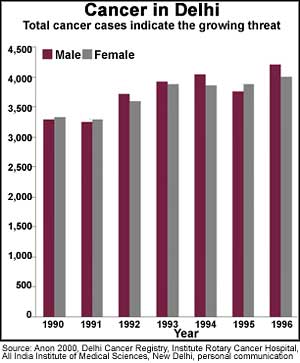Today's Plague
Today's Plague

T he six cancer registries in India fail to give the true picture of cancer incidence as several cases go unreported. Vinod Raina, additional professor of medical oncology at aiims , recently stated in a television programme that only about 30 per cent of the patients diagnosed with cancer undergo treatment because of the cost and many drop out halfway, having run out of money. Yet, whatever indicators are available do not present an encouraging picture (see graph: Cancer in Delhi ).
Randip Guleria, assistant professor of pulmonary medicine at aiims who participates in a weekly lung cancer clinic, says, "My impression is that there has been an abnormal increase in certain cancers in Delhi, and cancers of blood and lung are two of these. And the problem is only growing, because cancer takes a lot of time to develop, a lot of exposure to toxins. The pollution that we cause today comes back as cancer 10-20 years hence.'
Data projections by the National Cancer Registry Programme of the Indian Council of Medical research show that cancer of the cervix would be the most common cancer in India by July 2001, accounting for more than 12 per cent of all cases. In Delhi, lung cancer is the commonest among men. Blood cancers are also a greater problem in the capital as compared to the other registries. A comparison of blood cancer rates in the late 1980s shows Delhi records the highest rate of occurrence of blood cancers among the six registries in India (see graph: Blood cancers: Delhi's bane ).
What are the reasons for these alarming trends? The causes of cancer are too diverse







